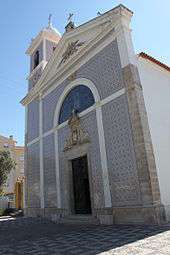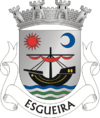Esgueira
| Esgueira | ||
|---|---|---|
| Parish | ||
| ||
 Esgueira | ||
| Coordinates: 40°38′46″N 8°37′44″W / 40.646°N 8.629°WCoordinates: 40°38′46″N 8°37′44″W / 40.646°N 8.629°W | ||
| Country | Portugal | |
| Region | Centro | |
| Subregion | Baixo Vouga | |
| Intermunic. comm. | Região de Aveiro | |
| District | Aveiro | |
| Municipality | Aveiro | |
| Area | ||
| • Total | 17.15 km2 (6.62 sq mi) | |
| Population (2011) | ||
| • Total | 13,431 | |
| • Density | 780/km2 (2,000/sq mi) | |
| Postal code | 3800 | |
| Area code | 234 | |
Esgueira is an urban civil parish in the municipality (concelho) of Aveiro, in continental Portugal. The population in 2011 was 13,431,[1] in an area of 17.15 km².[2]
History

The history of Esgueira remotes to the early medieval: the first document referring to the region dates to 1050. Specifically, the texts refer to the maritime waters of Esgueira.[3] Outeiro was the locality where the first inhabitants settled.
There are several interpretations of the toponym. That proposed by Monsenhor João Gaspar stands out: Iscaria meant "outeiro", a rocky elevation above Ribeira, the place where now stands the pavilion of Clube do Povo de Esgueira, formerly "Parque do Outeiro".
Its geographic location, alongside tidal flats, permitted, until the 17th century, the development of the salt industry.[3] An active centre in salt commerce, Esqueira was the seat of its jurisdiction (over thirty 31 towns and 10 municipalities).[3] It received a foral (charter) in 1110 from the Count Henrique.[3]
In 1116, the Monastery of Lorvão had possessions in the town, which the Afonso Henriques enlarged in 1176, with the donation of Taboeira, among others.[3]
It was Sancho I that in October 1210, provided Esgueira to his daughter D. Teresa in his testament.[3]
On 8 June 1515, a new foral was issued by Manuel I of Portugal.[3]
During the reign of John III there was a reorganization of the territorial divisions of the kingdom, resulting in the establishment of new comarcas, including Esgueira on 20 December 1533. Between 1528 and 1836, Esgueira was a municipality, consisting of the parishes of Esgueira, Cacia, Nariz and Palhaça, whom, by 1801, included 4426 inhabitants.[3]
With the elevation of Aveiro to city, the lands were converted into crown lands, after the Dukes implicated in the attempted assassination of Joseph I of Portugal were executed: the privileges of the Dukes were removed, and transferred by 6 November 1836 decree, extinguishing the municipality and annexxing Esgueira (as a simple parish) to the municipality of Aveiro.[3]
Geography
The civil parish consists of various localities, including: Senhor do Álamo/Cruzeiro, Bairro do Vouga, Agras do Norte, Cabo Luís, Bela Vista, Taboeira, Quinta do Simão, Mataduços and Paço.
Esgueira is a relatively young residential population.
Esgueira has an annual population of approximately 3050 students, distributed among five kindergarten/primary schools (including EB1/JI Taboeira, EB1/JI Esgueira, EB1/JI Alumieira, EB1/JI Quinta do Simão and Cabo Luís/Bela Vista), one middle-school (Escola Básica 2º/3º Ciclos Aires Barbosa), and a secondary school (Escola Secundária Jaime Magalhães Lima).
While the community strives to establish a health centre, it is served by a health outpost on the ground floor of the municipal hall, in addition to a center for handicapped rehabilitation, medical clinics, two dental clinics, two pharmacies, a center for clinical analysis and centre for surgery.
Architecture
Civic
- Residence of Carvoeira (Casa da Carvoeira/Casa da Cultura de Esgueira)[4]
- Residence of Esgueira (Casa de Esgueira/Creche e Jardim de Infância da Santa Casa da Misericórdia de Aveiro/Solar das Famílias dos Almeida e Eça)[5]
Religious
- Chapel of Nossa Senhora da Ajuda (Capela de Nossa Senhora da Ajuda)[6]
- Chapel of Nossa Senhora da Alegria (Capela de Nossa Senhora da Alegria/Capela do Álamo)[7]
- Chapel of São Pedro (Capela de São Pedro)[8]
- Chapel of the Espírito Santo (Capela do Espírito Santo)[9]
- Chapel of Sol-Posto (Capela em Sol Posto)[10]
Sport
In addition to futsal, gymnastics and athletics, the Casa do Povo de Esgueira's badminton team has been successful at the district, national and international circuits. In addition to the Casa do Povo's recreational association, the Associação Desportiva de Taboeira has been responsible for training soccer. The team C.P.Esgueira play at 2nd Division Portuguese basket." Pro Liga".
References
- ↑ Instituto Nacional de Estatística
- ↑ Direção-Geral do Território
- 1 2 3 4 5 6 7 8 9 Junta Freguesia, ed. (2012), História (in Portuguese), Esgueira (Aveiro), Portugal: Junta Freguesia de Esgueira, retrieved 5 October 2013
- ↑ Matias, Cecília (2009), SIPA, ed., Casa da Carvoeira/Casa da Cultura de Esgueira (IPA.00008705/PT020105050058) (in Portuguese), Lisbon: SIPA – Sistema de Informação para o Património Arquitectónico, retrieved 5 October 2013
- ↑ Dordio, Paulo; Guimarães, Maria (2000), SIPA, ed., Casa de Esgueira/Creche e Jardim de Infância da Santa Casa da Misericórdia de Aveiro/Solar das Famílias dos Almeida e Eçaa (IPA.00010864/PT020105050062) (in Portuguese), Lisbon: SIPA – Sistema de Informação para o Património Arquitectónico, retrieved 5 October 2013
- ↑ Matias, Cecília (2006), SIPA, ed., Capela de Nossa Senhora da Ajuda (IPA.00024379/PT020105050094) (in Portuguese), Lisbon: SIPA – Sistema de Informação para o Património Arquitectónico, retrieved 5 October 2013
- ↑ Matias, Cecília (2011), SIPA, ed., Capela de Nossa Senhora da Alegria/Capela do Álamo (IPA.00024380/PT020105050095) (in Portuguese), Lisbon: SIPA – Sistema de Informação para o Património Arquitectónico, retrieved 5 October 2013
- ↑ Matias, Cecília (2009), SIPA, ed., Capela de São Pedro (IPA.00024383/PT020105050098) (in Portuguese), Lisbon: SIPA – Sistema de Informação para o Património Arquitectónico, retrieved 5 October 2013
- ↑ Matias, Cecília (2009), SIPA, ed., Capela do Espírito Santo (IPA.00024378/PT020105050093) (in Portuguese), Lisbon: SIPA – Sistema de Informação para o Património Arquitectónico, retrieved 5 October 2013
- ↑ Matias, Cecília (2006), SIPA, ed., Capela em Sol Posto (IPA.00024381/PT020105050096) (in Portuguese), Lisbon: SIPA – Sistema de Informação para o Património Arquitectónico, retrieved 5 October 2013
